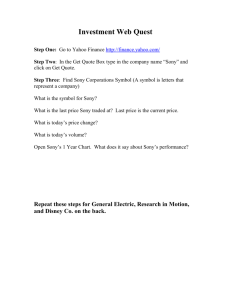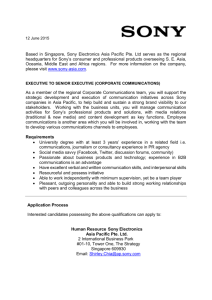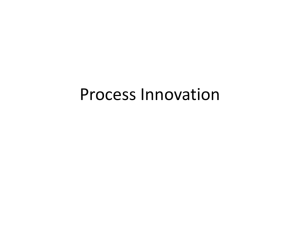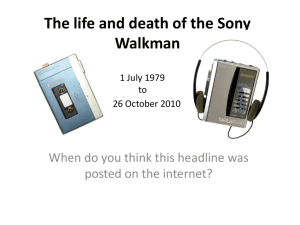Strawberrychickky-BG2001-English4-midterm
advertisement
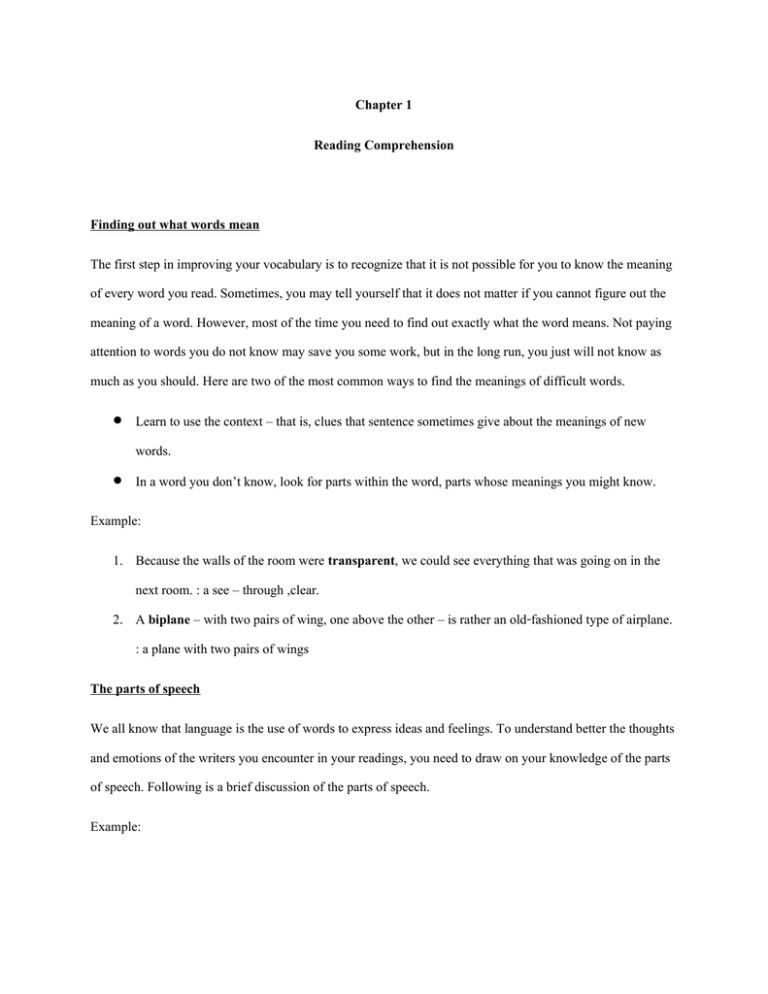
Chapter 1 Reading Comprehension Finding out what words mean The first step in improving your vocabulary is to recognize that it is not possible for you to know the meaning of every word you read. Sometimes, you may tell yourself that it does not matter if you cannot figure out the meaning of a word. However, most of the time you need to find out exactly what the word means. Not paying attention to words you do not know may save you some work, but in the long run, you just will not know as much as you should. Here are two of the most common ways to find the meanings of difficult words. Learn to use the context – that is, clues that sentence sometimes give about the meanings of new words. In a word you don’t know, look for parts within the word, parts whose meanings you might know. Example: 1. Because the walls of the room were transparent, we could see everything that was going on in the next room. : a see – through ,clear. 2. A biplane – with two pairs of wing, one above the other – is rather an old-fashioned type of airplane. : a plane with two pairs of wings The parts of speech We all know that language is the use of words to express ideas and feelings. To understand better the thoughts and emotions of the writers you encounter in your readings, you need to draw on your knowledge of the parts of speech. Following is a brief discussion of the parts of speech. Example: Jack quickly entered the didot and cleaned the various misturaes he had been using to repair his wuipit. He had often thought that this job was extremely yulling. However, he had to admit that this time things seemed to be a bit easier. When he finished, he put on his redick and went back to the study to relax. He took out his favorite pipe and settled into the beautiful new pogtry. What a fantastic schnappy he had made when he had bought the pogtry. Only 300 yagmas! 1. What could a “didot” be ? Answer: shed / workshop 2. What part of speech is “misturaes” ? Answer: noun 3. If Jack used the “misturaes” to repair the “wuipit”, what do you think the “misturaes” must be? Answer: tools 4. What could “yulling” mean? Answer: hard Determining the main idea The main idea og paragraph is the thought that is discussed from the beginning to the end. Being able to determine the main idea of paragraph is one of the most useful reading skill you can develop and apply to any kind of reading. Example: Facebook’s new online messaging service makes users of the social networking site more vulnerable to identity by cybercriminals. It urged users to be aware of the security risks before signing up for Facebook’s next-generation online messaging service. The service blends online chatting text messages and other realtime conversation tools with traditional emails so users need to realize that these new features increase the attack surface on the Facebook platform, and make personal accounts all the more attractive for cybercriminals to break into. Users also need to be aware that Facebook will be storing a complete archive of all their communications with one person. This raises concerns as to how this data could be misused if it fell into the wrong hands. Title of the paragraph: Facebook Messaging Poses Risks for Users Chapter 2 Reading Comprehension The method of summarize and analyze the provided passage based on your understanding and write it down in your own word. How to write the perfect paragraph: 1. Every paragraph should have one topic sentence and followed by the supporting sentences. Caution: Topic sentence must have a verb not just a phrase. For example: There are many reasons why people keep pets. Or People have pets for many reasons. 2. Before writing, you should think what you are going to write down. For example: Gold is a very good investment (Topic Sentence) You can give the reasons and characteristics that make goal attractive to investors. -Supporting sentences will be included: -Gold is fluctuate -People buy and sell -Banks store gold because it’s safer that money -Countries also store gold. 3. Link all supporting sentences by using proper transitions Transitions to introduce an additional idea or to add something In addition, additionally, and, in addition to, and additional…,moreover, besides, also, too Transitions to introduce an opposite idea or contrast On the other hand, in contrast, by contrast, however, nevertheless, instead, still, but, yet, although, though, even though, whereas, while, in spite of…, despite…. Transitions to introduce a choice or alternative Otherwise, or , if, unless Transitions to introduce a statement or explanation That’s … Transitions to introduce an example For example, for instance, an example of…., such as… Transitions to introduce a conclusion or summary Finally, in conclusion, in summary, to conclude, to summarize Transitions to introduce a result Therefore, consequently, hence, thus, as a result, as a consequence, so 4. Before doing reading comprehension, you must read the questions to be able to understand and find the keywords easily. Note: the answer contains 2 paragraph for each question. Word limitation is 150 words, so you have to write about 75 words for each paragraph. Exercise: Read the passage and follow the instructions. Sony Thailand will spend Bt 1.3 billion this year on marketing its Bravia LCD TV’s, Cyber-shot compact digital cameras, Alpha professional cameras and Vaio laptops to achieve sales growth for 10 per cent after zero growth in its last fiscal year. The company will use “cluster value marketing” to market these four product categories, meaning will convince customers to buy more than one product by positioning the Bravia LCD TVs as the main product and linking their use to other Sony products such as Handycams, digital cameras, Blu-ray DVD, players displays and audio systems. The Bt1.3 billion marketing budget will be spent on TV, magazine, newspaper, and point-of-sale advertising as well as on joint activities with business partners and roadshows. It will also focus on improving the product displays at its outlets. Managing director Taisuke Nakanishi yesterday said Sony Thai was confident or achieving its growth target for 2015 fiscal year, despite the current political instability and steep inflation. It has already seen good performance in the first two months (April and May) and expects the Euro 2015 soccer tournament to boost its performance. It expects to see growth in all major categories: 30 per cent each for TVs and laptops, 15 per cent for camcorders and 10 per cent each for digital cameras and audio systems. “The economic slowdown and price competition last year made us experience zero growth. However, we increased market share in many categories,” he said. Sony’s marketing plan for the Bravia is to attract first-time LCD TV buyers and consumers who want a spate TV in their bedroom by introducing 20-inch models in five colours, and to temp current LCD TV owners with new 40-inch-plus models with Full High Definition (Full HD) technology. Yoji Higashida, Sony Thailand’s general manager for the consumer marketing growth, said smaller models still made up only a fraction of the whole LCD TV market in Thailand and no competitor had focused on models with stylish design for personal use. Sony expects such models to make up ten per cent of Bravia’s sales this fiscal year. After seeing demands for its 40 –inch-plus LCD TVs, the company decided to upgrade the category by introducing Full HD technology in all such models. It expects its large TVs to increase their share of overall sales from 20 to 25 percent this fiscal year. In the Handycam category, Sony recently launched a new model made form titanium that it claims is the slimmest, smallest and lightest in the world. Sony also plans to offer Cyber-shot digital cameras in a wider range of colors and with a new “smile shutter” function that works only when it spots smiling faces. Sony’s Vaio laptops will also now come in a range colors after a survey last year found that 70 per cent of users preferred colored models to the traditional black. Sixty percent of digital camera users said they preferred colored model. “it’s going ot be an exciting and challenging year for Sony Thai and I am confident that the Thai public will respond positively to this campaign, “Mr. Higashida said. Adapted from The Nation. Instructions: Answer the following questions in 140-150 words. Question: Describe Sony Thailand’s marketing strategies to sell its products. Do you think these strategies will work? There are several strategies Sony Thailand will use to increase their sales. The first strategy is the investment on marketing this year. The company will spend BT 1.3 billion to advertise its product by using “cluster value marketing”. This marketing strategy will help it sells more products related after consumer purchase one product. Secondly, Sony will introduce many interesting new products. For example, Sony focuses on new LCD TV buyers by introducing 20-inches-models with full HD to current LCD TV owners. Moreover, Sony offers new function likes Smile shutter and more fashionable model by launching many colors. I think the strategies will work. First of all, Sony Thailand introduces new products with high technology, new functions and many colors. The company can compete over others because wide range and high technology products will attract consumers to buy its products. Secondly, Sony is a popular brand name and good marketing. Unsurprisingly, it can easily introduce its new products and make consumers believe in its products. Lastly, there will be two events which are Olympics and Euro Soccer tournament. So, consumers will consider to buy a new technology product. Chapter 3 Editing and Proofreading Common Questions Concerning Grammar 1) A or An - use a before a consonant sound; use an before a vowel sound. 2) Accept or Except - Accept is a verb meaning "to receive" or "to approve." Except is a preposition meaning "excluding" or "leaving out." Except can also be a verb meaning "to leave out" or "to exclude." 3) Active or Passive Verbs - The voice of a verb indicates the strength of the subject in a sentence. It tells us whether that subject takes action or receives action. There are two possible voices: active and passive. In the active voice, the stronger form, the subject of the sentence takes the action of the verb. 4) Affect or Effect - Affect is a verb meaning 'to influence.' Effect is a noun meaning a result.' More rarely, effect is a verb meaning 'to cause something to happen.' 5) Amount or Number - Amount should be used to refer to quantities that cannot be counted or cannot be expressed in terms of a single number. - Number is used for quantities that can be counted. 6) Apostrophes - The apostrophe has four main uses: 1. To show the omission of numbers in such expressions as Christmas '98 or letters in expressions that imitate certain patterns of speech 2. To form contractions 3. To form plurals of single numbers and letters 4. To form possessives 7) Among or Between - When only two are involved, the answer is easy: between. - Use among if you're thinking of the group. 8) And or But 9) Capitalization in Titles For a list of all the rules about capitalization, follow these instructions: 1. Go to the top of this page and use the "click here" feature to learn more. 2. Scroll down and click on "capitalization and spelling." 3. Click on "capitals," and you'll come to the rules of capitalization. 10) Commas 11) Everyone or Everybody - Everybody and everyone are interchangeable. Anyone and anybody are also interchangeable. 12) Farther or Further - Use farther to refer to physical distances.Further refers to quantity, time, or degree. 13) Hyphenation 14) If or Whether - Use if for a conditional idea, whether for an alternative or possibility. 15) Parallelism - Parallelism is the expression of similar or related ideas in similar grammatical form. Besides emphasizing the relationships of ideas, parallelism can create intriguing sentence rhythms and highlights." "Once you begin a parallel pattern, you need to complete it. If you mix structures, creating incomplete or faulty parallelism, your sentences may disappoint readers' expectations and be hard to read. 16) Reason is because - Reason is because is a redundancy. Use reason is that . . . . The reason we recommend 'reason is that' is that the grammatical subject, reason, is balanced by a noun clause in the predicate, headed by that 17) Run-on sentence 18) Semicolon use - A semicolon creates a brief reading pause that can dramatically highlight a close relationship or a contrast. The semicolon alone can't specify the relationship the way words like because or however can. Be sure, therefore, that the relationship you are signaling won't be puzzling to readers. 1. Join two sentences with a semicolon. A semicolon joins main clauses that can stand alone as complete sentences. 2. Use a semicolon with words such as however and on the other hand. When you use a semicolon alone to link main clauses, you ask readers to recognize the logical link between the clauses. When you add words like however or on the other hand, you create a different effect on readers by specifying how the clauses relate. 3. Use a semicolon with a complex series. When items in a series contain commas, readers may have trouble deciding which commas separate parts of the series and which belong within items. To avoid confusion, put semicolons between elements in a series when one or more contain other punctuation. 19) That or Which or Who - Do not use which to refer to persons. Use who instead. That, though generally used to refer to things, may be used to refer to a group or class of people. 20) Transitive verb or Intransitive verb - Any verb that requires a direct object is known as a transitive verb - Verbs that do not take objects are intransitive verbs. ************************************** 10 types of errors in English 4 1. 2. 3. 4. 5. 6. 7. 8. 9. 10. Unrelated sentence Capitalization Punctuation > Full stop, Comma Number: Singular or Plural Subject-verb Agreement Verbs Articles Prepositions Pronouns Word Forms ********************************** Example Read the paragraph carefully and follow the instruction Two checkpoints on the Thai-Cambodian border, in Surin and Si Sa ket, re-opened on Wednesday after local military leader of both country held another round of ceasefire talks. An immigration checkpoints in Surin’s Kap Choeng district was re-opened at 10 A.M. Wednesday. Field reports said that the Thai 2nd army commander went across the border for meet with the Cambodian commander at the O-Smach Resort Hotel not far from the crossing. The two military commanders discussed strictly implementation of a ceasefire. There are many casinos on the Thai-Cambodian border. They agreed that if there is a clash the unit commanders of the two sides must immediately contact each other. He also agreed to re-open the Chong Jom-O-Smach immigration checkpoint. After the talks, the thai commander flew by helicopter to visit wounded soldier at a military hospital in Surin province. The Chong Jom-o-Smach crossing open at 10 A.M. by the official to the relief of traders on both sides of the border. It had been closed for 13 days, stop cross-border trade. Key : Two checkpoints on the Thai-Cambodian border, in Surin and Si Sa ket, re-opened on Wednesday after local military leader of both countries held another round of ceasefire talks. An immigration checkpoint in Surin’s Kap Choeng district was re-opened at 10 A.M. Wednesday. Field reports said that the Thai 2nd army commander went across the border to meet with the Cambodian commander at the O-Smach Resort Hotel not far from the crossing. The two military commanders discussed strict implementation of a ceasefire. There are many casinos on the Thai-Cambodian border. They agreed that if there is a clash, the unit commanders of the two sides must immediately contact each other. They also agreed to re-open the Chong Jom-O-Smach immigration checkpoint. After the talks, the Thai commander flew by helicopter to visit wounded soldier at a military hospital in Surin province. The Chong Jom-o-Smach crossing was opened at 10 A.M. by the official to the relief of traders on both sides of the border. It had been closed for 13 days, stopping cross-border trade. Chapter 4 Data interpretation Example 1: Why Thai students study English High school students 3% 24% 58% 15% Movie,music and chat Future work school subject study abroad University students 19% 10% 30% 41% Movie,music and chat Future work schoo subject study abroad Instruction: Explain the information contained in the graph and give some reasons to describe the important trenda in 165-175 words The two pie charts are about the four reasons why Thai high school and university students study English. They both study English as school subject, to study abroad, for movies, music and chat, and future work. Clearly, English is most studied as school subject by 58% of high school and 41% of university students. 24% and 10% respectively go for movies, music and chat. Whereas only 3% of high school students learnt English to study abroad, there are 19% of university students do so. Moreover, 30% of university students, double the percentage of high school students, study English for future work. Thai's high schools and universities teach English as a compulsory subject. High school students study English for formal usage like taking exams, and informal usage understanding and enjoying movies, music, and speaking with others. Studying abroad or working are not their immediate needs. Nevertheless, university students get more interested in work possibilities and further studies abroad due to their age. Therefore, they have not much time to char or for other entertainments. 173 words Example 2: Methods of transportation in Bangkok by percentage 40% 35% 30% Bus 25% Car 20% Boat 15% foot 10% other 5% 0% 1989 1999 2009 Instruction: Explain the information contained in the graph and give some reasons to describe the important trenda in 165-175 words The line graph shows the percentage of transportation methods in Bangkok in 1989,1999 and 2009. They are bus, car, boat, walking and others such as bicycle, sky train, etc. The first decade showed the rise in users of bus and cars to about 27% and 23% respectively. In the next decade, although car users increased steadily to around 35%, bus users decreased to almost where it began, In1999, boat users were around 5% decrease and the percentage of walker dropped to approximately 17%. Those using bicycle, etc. also decreased by roughly 3% Bangkokians used to walk to places twenty years ago. However, both the rapid and gradual decline of walkers to 1999 and until 2009 indicated that much walking was now replaced by driving cars. Many can afford cars as quick and efficient transportation mode. Traditional mode, boat, was used by few for fear of accident and danger due to lack of maintenance and polluted waterway. The popularity of buses also decreased because of the innovation of more time-saving and convenient sky and underground trains 175 words

